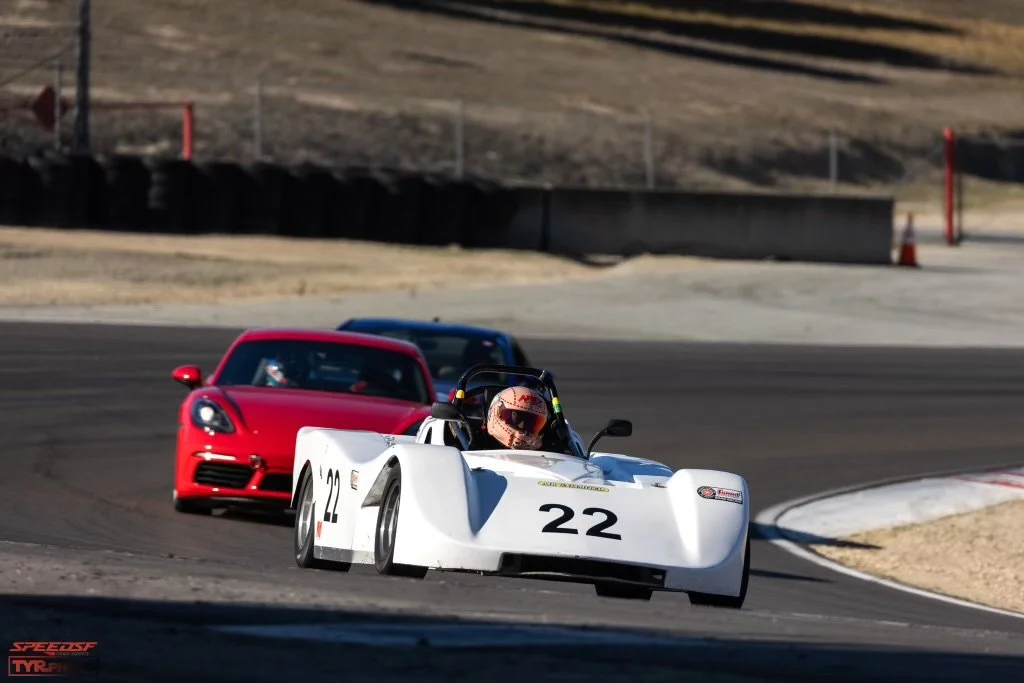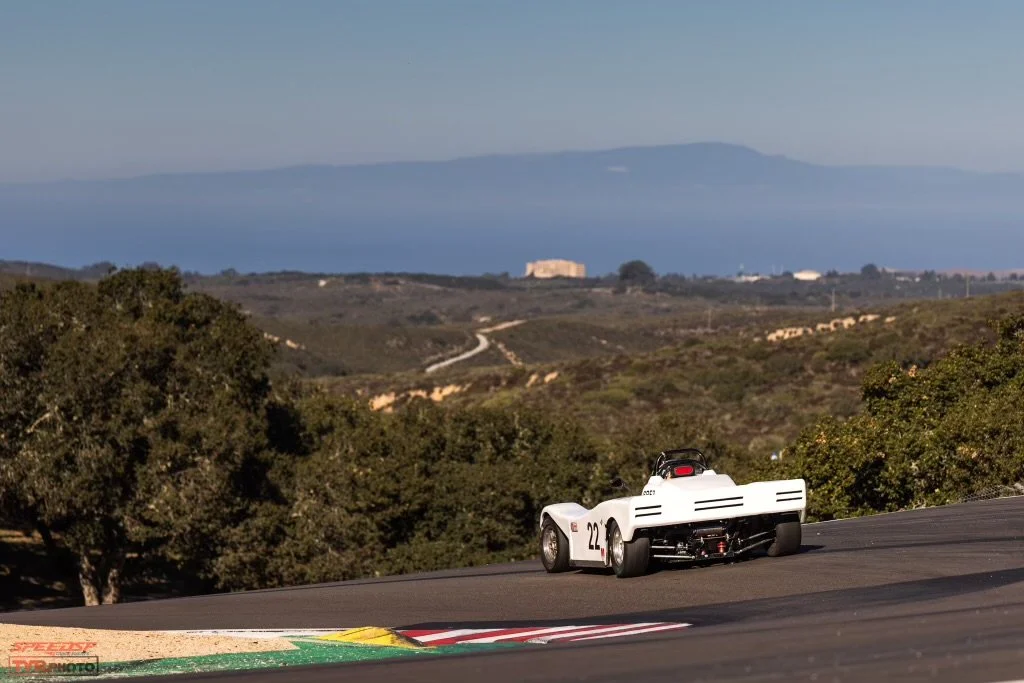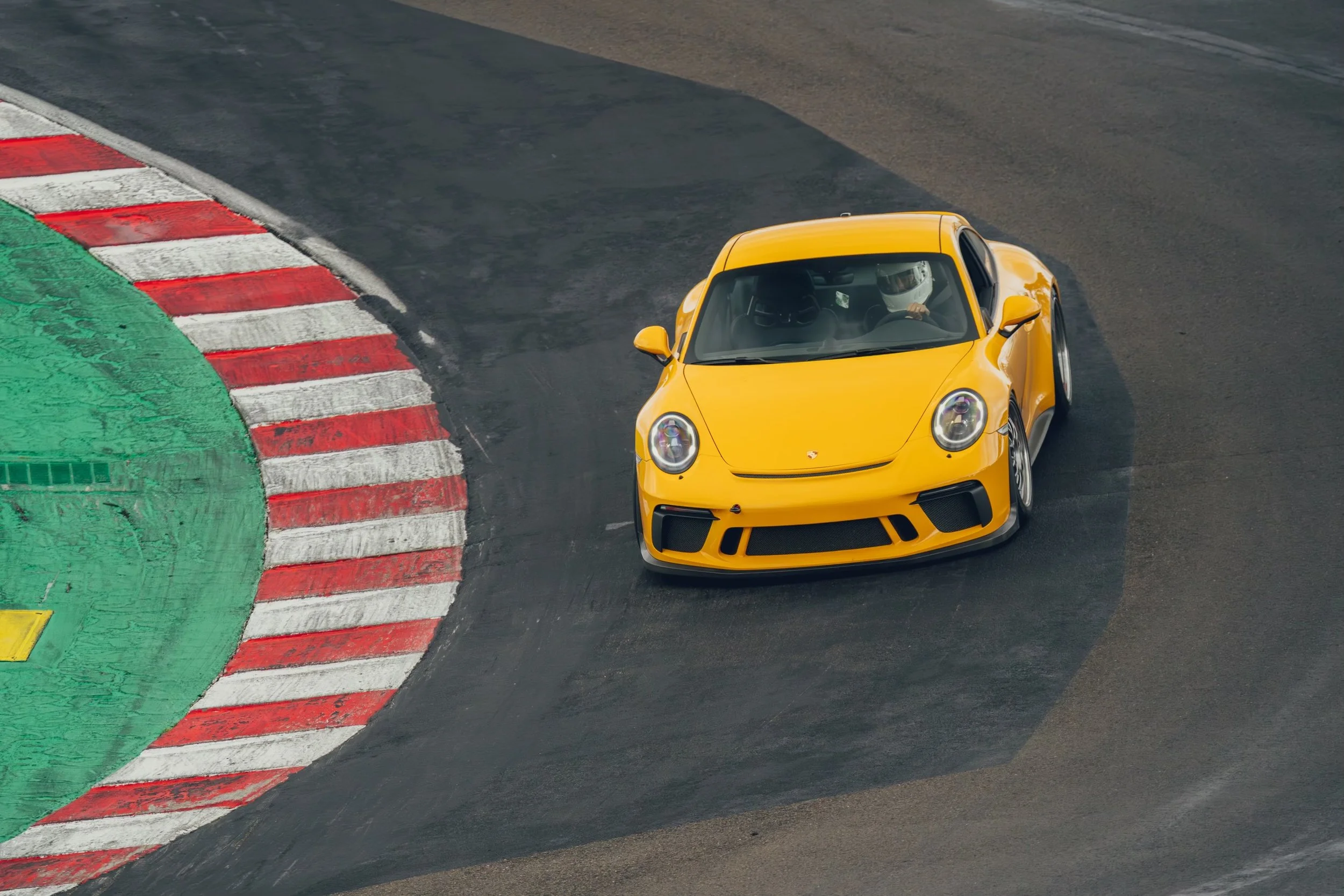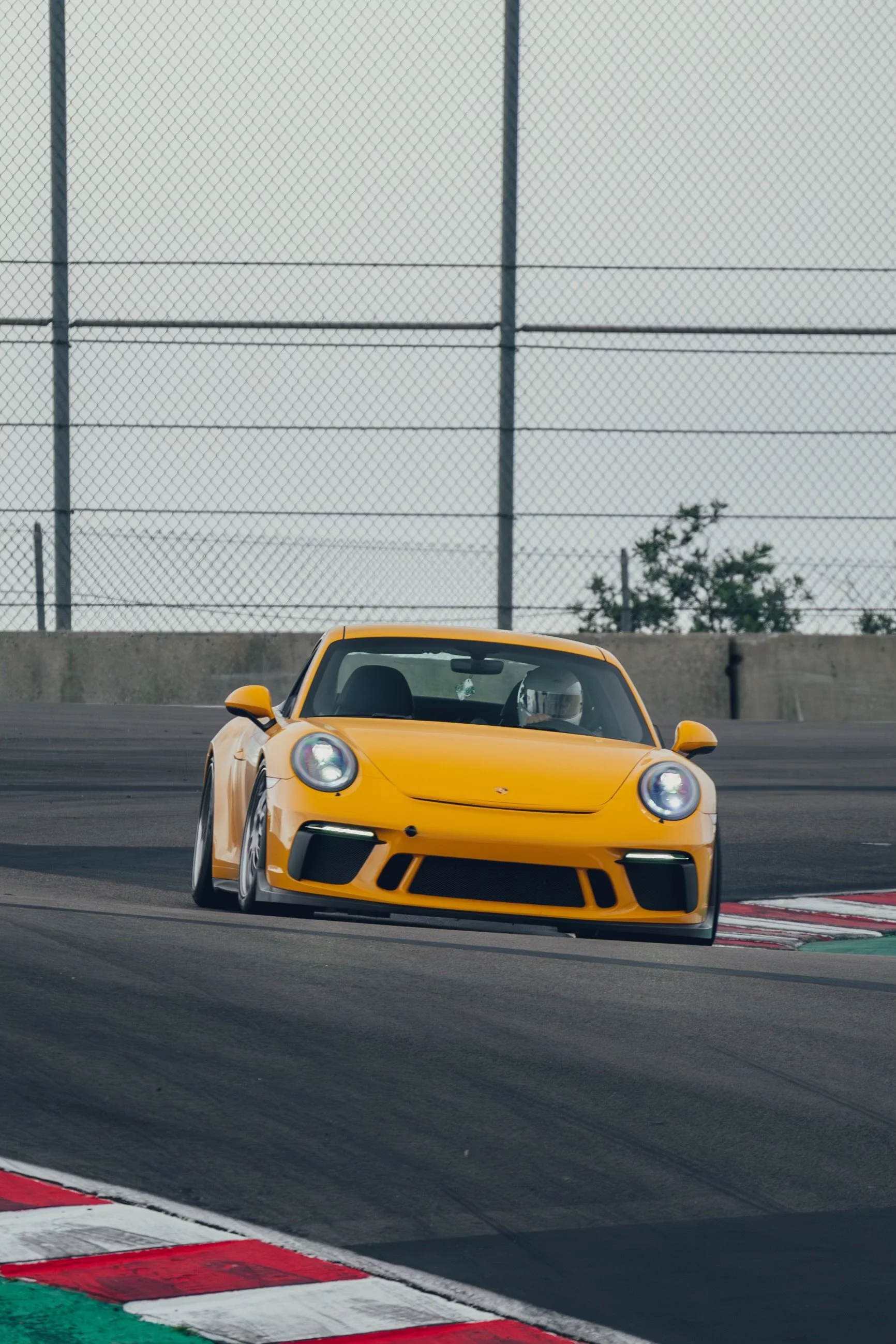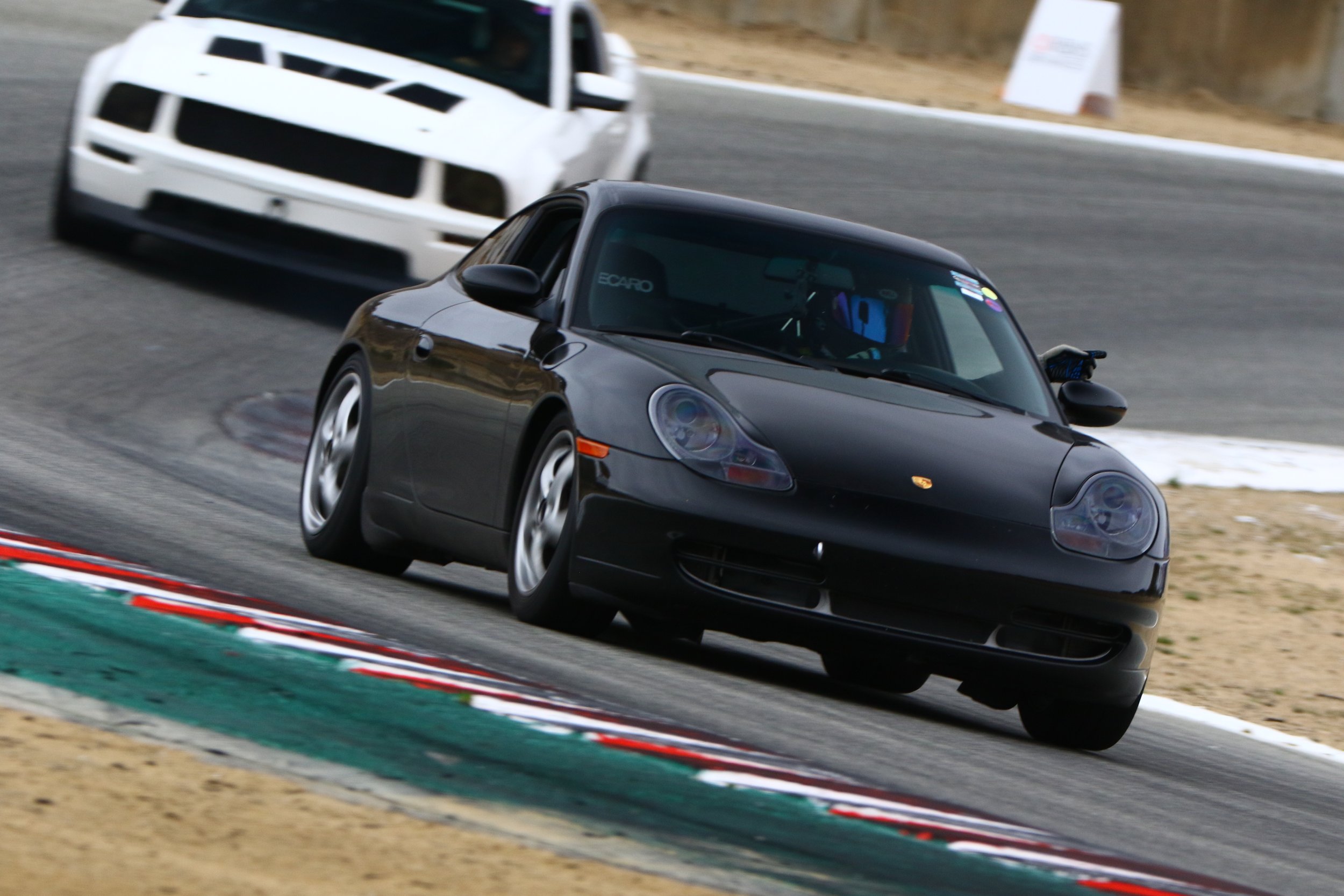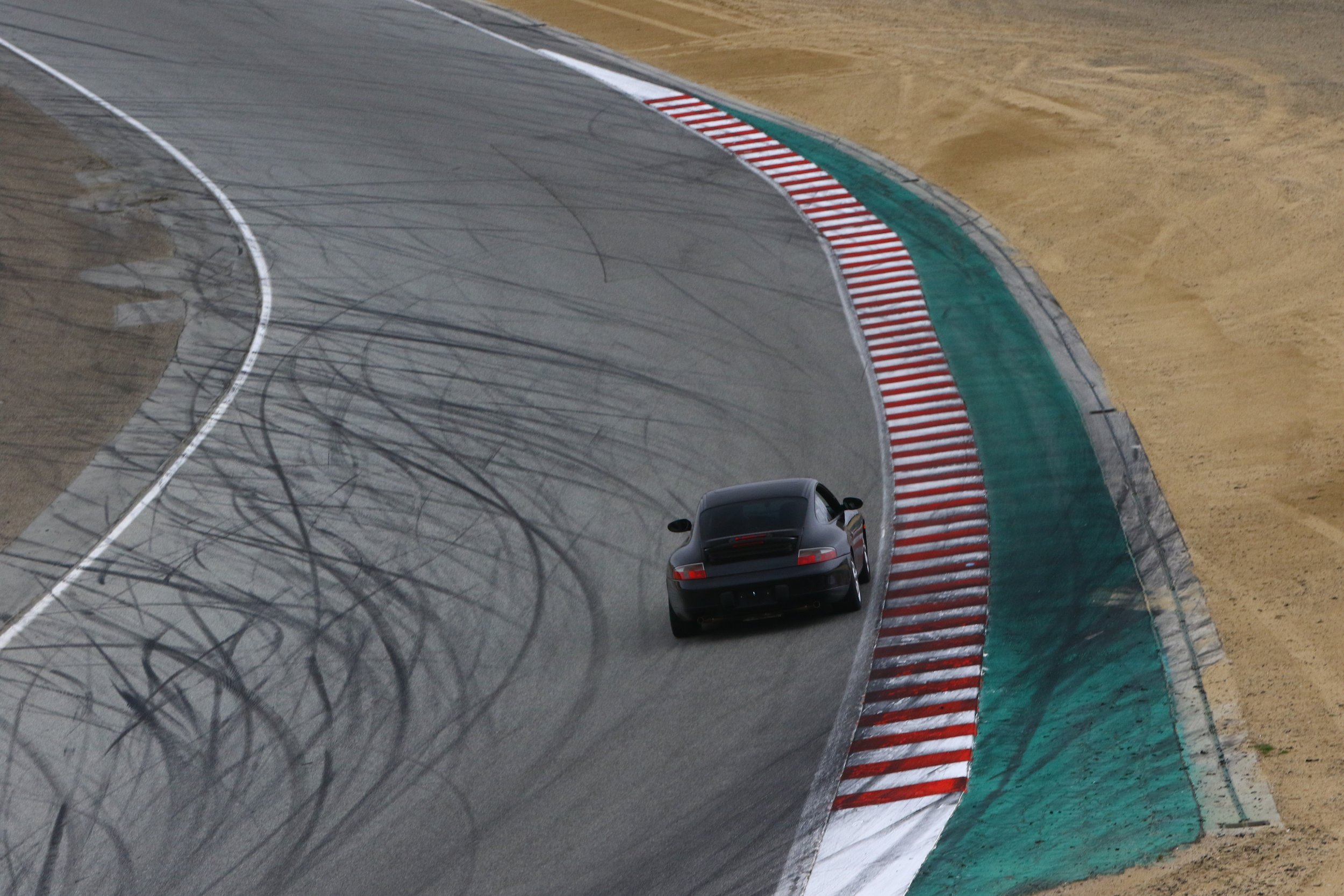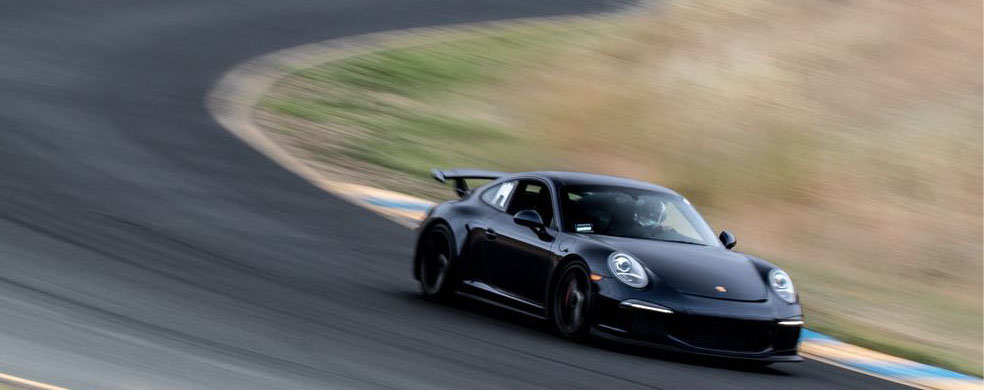
Max’s Spec Racer Ford: Lose The Ego
After cutting his teeth in a Porsche, Max got an inkling that going to a lighter, cheaper, more expendable device might expedite his improvement as a driver and budding racer.
After Max Gokhman signed for his 2006 Cayman, his dealer insisted that he take the car to the track. “You won’t be able to fully appreciate it if you don’t,” he said. Max was hesitant — the thought of balling up his brand new Porsche terrified him, but, at the same time, he sensed the man knew what he was talking about.
Max continued to mull over the prospect of tracking his new toy, but his dealer was adamant — so much so he offered to pay Max’s entry fee. That was all Max needed to make a decision. The next weekend, he took the Cayman to Infineon Raceway and began a love affair that never tested his patience. No crashes, no major repairs, and a relatively straightforward relationship with his parts suppliers made his first few years in grassroots motorsports a breeze.
Soft Ascent
After becoming the 2014 PCA Autocross Class Champion and multiple podium-sitter in various Southern California time attack series, he sold the 987 and moved into a 2014 981 Cayman. This time, however, he wasn’t as eager to modify the car. He’d come to understand the practical shortcomings of a track-oriented car and felt he might get more from the ownership experience if he was to leave the car mostly stock.
It was around then that one of his track buddies enticed him into wheel-to-wheel racing. This would entail buying a race-only machine. Truth be told, he had considered it for some time, but the thought of wadding up a Porsche racing car turned his stomach. Even getting on track in one would be prohibitively expensive, so he explored the cheaper options available to him.
He could drive a Spec Miata for a reasonable price, but he wanted something a little different. “I was looking for a mid-engined, purpose-built platform, and — and this is subjective — something a little more interesting than a Miata,” he explained.
He loved the idea of running a “spec” car: something that encouraged close competition through mechanical parity. What about something with the same power of a Miata, but in a car which weighs one thousand pounds less? The tried-and-true Spec Racer Ford, a staple of grassroots motorsport for the last fifty years, caught his eye. Mid-engine, open-top, closed-wheel, and very cost-effective; there was a lot to like about this diminutive, bare-bones racer.
Barest Bones
The tube-frame chassis has a 1.6-liter engine from a Ford Focus sitting transverse behind the driver. These sealed engines produce 135 horsepower, and are fairly inexpensive to replace when they go bang — though this rarely happens. The emphasis here is on reliability, low running costs, and complete driving immersion.
When Max first tested the car at Laguna Seca, he was setting competitive times by the end of the day.
The sense of occasion is something that can’t be underestimated with an open-top car like this. Not only is the visibility fantastic, but getting your helmet buffeted by the wind makes driving at seventy feel like a hundred and twenty. The information relayed by the car is detailed and constant; it’s easy to feel a locked tire or growing understeer through the steering, which is remarkably sharp. “Feedback is crystal clear,” he adds.
Sitting in the middle of the chassis and knowing exactly where your front wheels are at all times inspires confidence to get real intimate with other racers when going three-wide into a turn - truly what wheel-to-wheel is about.
Some might suspect that a car this visceral and direct would come with sharp edges. In reality, it is predictable and communicative, and, as it has much more grip than power, it’s quite easy to find its limits. When it does slide, it’s fairly progressive — more so than the Cayman; nearly 300 horsepower would cause a few dicey situations when passing in a late-apex turn. Some of this is due to a compliant suspension setup, and some of it is due to the Hoosier slick made specifically for the SRF. Incidentally, it isn’t the most expensive tire. Low weight and low power help lengthen its lifespan, too.
The sequential transmission by Sadev, standard in third-gen SRFs, is another racecar element that Max learned to appreciate. Unlike an H-pattern, which is lovely for canyon drives but saps attention from racecraft; or a PDK, which is clinically precise yet fragile on cars that were built for the street; the SRF gearbox lets you bang out shifts while bouncing off the rev-limiter with abandon.
Perspective Shift
Max admits that, while the Spec Racer Ford is the more engaging car to drive, he doesn’t have the same sentimental attachment to it as he had to his Cayman. “I save the sweet feelings for my Porsche. This is a tool to help me grow as a racer. I compare the distinction between the two to owning a pet versus owning livestock.”
And with the reasonable running costs, packed fields, low power, and full calendars, he’s looking to become a competitive amateur racer as he gets up to speed on the Spec Racer Ford platform, with the help of his team Accel Racetek.
“Once I got competitive with this hobby, I learned that money spent on coaching would make me a lot faster than aero, suspension, or other bits of kit. To me, some of those seem most like things to flex over. With Perry and Travis of Accel Racetek, I not only know that the car will be ready for the next race no matter what tomfoolery I get up to on track, but that they’ll keep nudging me to be a better driver.”
Ultimately, the moral here is that with racing, as with any other passion, dropping your ego — such as by going from a venerable Porsche to a humble Spec Racer Ford — may prove to be the path to success, paved with smiles.
Aidan’s GT3: Vision Realized
Driven to realize a very specific dream built on years of tuning high-revving Hondas, Aidan decided that this 991.2 GT3 would have the subtle cosmetic touches to wow crowds and the high-end racing modifications to set seriously impressive lap times.
Photo credit: @z_stills & @tengerphoto
As Aidan Vo moved through adolescence, his affinity for cars carved out a prominent place for him in the San Jose drag racing scene. After he built an all-motor DC2 Integra capable of twelve-second passes, the big magazines came calling. This was the early 2000s, when the tuning scene was enjoying its biggest boom.
Through some of his drag racing acquaintances, Aidan eventually made the leap into road racing. Following his foray at Thunderhill, he started outlining a list of changes the Integra needed to become a corner carver, and for a moment, it looked like Endless might foot the bill.
So Aidan began disassembling the Integra and shelving the parts which wouldn’t do much good around a road course. Halfway through the teardown, he had a change of heart. He parted the car out, sold the chassis to another racer, and decided to hitch himself to the all-wheel drive wagon that’d just reached American soil.
It was in a Subaru WRX STI that really learned how to turn fast laps. His confidence bolstered by the safe, accommodating four-wheel drive, he earned his spurs in relative comfort. Then he switched camps and built a cost-no-object Evo X, which earned several magazine spots. Not only had he become well known and capable around a road course, he’d been rewarded for expressing his inner vision.
As his income grew, he started searching for a new platform. Something with a little more panache — something German.
The big Audi RS4 might not have been at home on the track, but the fit and finish of a plusher, posher machine did spark his imagination. There was something distinctive about it; something which resonated with Aidan and his appreciation for high style. The jump into the Euro market got his imagination running, but, unfortunately, that would be the extent of his involvement with cars for some time.
After living through the height of the tuner craze and enjoying all that the burgeoning market could offer, Aidan stepped away from cars to focus on his career and his growing family. All throughout this quieter interim, he couldn’t successfully quiet one part of his mind. “I missed that buzz; I had to create and build again,” he reflected.
Ten years of car-free focus had done wonders for his finances. Not completely car-free, however; he spent many evenings over that decade drooling over builds his younger self could never afford. When Aidan decided to return to his old hobby, he brought with him the means to realize a plan he’d held for a decade.
“I’ve always been captivated by the Porsche 911 since the 993 generation,” he began. “It’s always had a clean, restrained, understated design — that’s a big part of my aesthetic.”
A few weeks later, he rolled his new 991.2 GT3 into his garage, parked it, and pictured the finished product in his mind with all his planned modifications. The challenge he’d set for himself was considerable, but he had a clear plan and a few connections to help him along.
The Singer DLS was the one machine which inspired the build. “I’m not a Porsche purist who doesn’t believe in tinkering on their car. I see a Porsche as a vehicle that I can use to promote my vision.”
Knowing that the name Manthey was synonymous with Porsche performance, he did what all GT3 owners with grand aspirations for their build would do: purchase Manthey’s complete suspension, brake, and aero package.
There are only a few GT3s equipped with these parts in the Bay Area, and for good reason — one kit costs as much as a newish economy car. Most struggle to justify spending nearly thirty grand on Manthey-tuned KW dampers, solid bushings, brake lines, pads, dry carbon wing, as well as a Cup car’s front splitter, but the resulting crispness and composure is worth it to those with discerning taste and deep pockets.
Perhaps the one downside was that, for all that money spent, the car didn’t look much different than it did prior to the modifications. With so many Porsches looking so similar, Aidan decided to give a nod to the Porsche styling of yore by replacing the factory GT3 wing with a Porsche Sport Design ducktail. He learned shortly after just how difficult it would be to swap out this piece, retain all functionality, all while using OEM Porsche parts — and only OEM Porsche parts.
A hundred calls to local dealerships resulted in the same sad message: “on indefinite backorder.” It took months of perusing before he found an appropriate ducktail from a local owner looking to return his Sports Design-equipped car to stock, but he finally found the part. With the ducktail in hand, he felt as if the build were gaining a momentum of all its own. “Finding that part gave me the confidence to continue doing things the way I want to do them. Everything happened so organically, it almost felt like destiny.”
It’s subtle, but it sets it apart from the rest of the winged GT3s driving around San Francisco.
Of course, the body and the engine underneath would require several tweaks to accept the new boot-lid. Aidan had to source a 911R intake, 911R engine cover, the hinges, every nut and bolts and the oil return lines to allow this new body panel fit snugly. Unfortunately, What would seem to be a simple swap took months and countless emails.
The tradeoff was obvious. “The ducktail definitely makes less downforce than the original wing, which I learned when trying to go flat over Turn 1 at Laguna Seca, but it helps with rear visibility.”
With used 911-money spent on the suspension, it would only make sense to do the same with the powertrain. With Dundon Performance on the phone, Aidan specced out an engine package that would uncork the power of the 991.2 GT3, more mid-range torque and a top-end that reminded him of some of his fastest Hondas.
Dundon provided him with an intake, throttle body, plenum, and headers. JCR provided their titanium race pipes and titanium exhaust tips. The combination of these parts together allows the car to scream like an RSR at redline while keeping a deep, sonorous growl at lower revs.
With the way the GT3 was evolving into something like a racing car, Aidan decided to try and give his car the front track and aerodynamic grip of its race-only sibling, the GT3 Cup. He rung up his contact at Manthey and ordered the primered fenders, flares, splitter, bumper, and crash bar from a bonafide 991.2 Cup car. His painter Jesus matched the new parts perfectly and even achieved OEM paint thickness.
And now Aidan has something that is undeniably his own. Even if it were for sale, his buddies would never attempt to buy it. “‘It’s so obviously his, I wouldn’t ever feel like I owned the car,’ one of my friends told me.”
But is it a show car or a track toy? Aidan doesn’t believe there needs to be any distinction between the two. He’s made steps towards having both distinguished looks and serious performance, and all that he’ll need to do to suit his mood is change a few bolts and reorient the engine fans.
“As pretty as the trunk is, it definitely lacks downforce compared to the Manthey carbon wing. I’ve planned ahead to regain the downforce we all crave at the track. I have a Cup decklid and wing ready for track days. That arduous ducktail swap was done specifically to allow swift decklid swaps when it comes time to take the GT3 back to the track. All you have to do is reorient the fans to fit the subframe brace. After that, you’re off to the track.”
At this point, he feels he’s nearly realized his vision. Aidan cannot see himself selling the car, but that doesn’t mean he’s going to make it a collection piece. Instead, he’ll put it through its paces, enjoy it as both a driving tool and a rolling piece of art, and hope that his commitment and the car’s obvious quality will inspire the next generation of speed freaks with an eye for design.
Nic's Porsche 911: Take a Chance on the 996
Take a risk and keep it simple. Nic Gerardi’s shown us that the 996.1 Carrera’s a great track car with the right modifications. Stout, light, full of feel, and very reliable, it might be worth the chance of a bad IMS.
Some of us get our start tracking in unusual equipment. Nic Gerardi began with a Volkswagen Jetta—a car which, by his admission, was “never really made for this sort of stuff.”
That wasn’t quite the cask with this 996.1. This 2001 Porsche 911 was, as he put it, “Just OK.” Being a base C2 Carrera, it was quite soft—more of a grand tourer, really. Running all-season tires didn’t help much there, either. “It pushed so much; it really wouldn’t leverage the rear,” he noted.
The fact that it was so soft allowed him to hustle the car over the curbs in a way he never felt comfortable doing in the Jetta. Part of that sense of security came from the general feeling of robustness he had when driving the 911—a car he believed to have more potential.
Wisely, Nic recognized that the driver was the limiting factor at that stage, so rather than begin by adding performance modifications, he decided to choose a collection of safety improvements. A four-point DAS Sport bolt-in rollbar, a Recaro pole Position ABE seat, and an OMP six-point harness gave Nic the sense of security he was after—a wise choice that helped him push the car to the limit and understand the Porsche’s demands.
After making the safety upgrades, he improved the wheel and tire combination—again for similar reasons. The wider set of APEX SM-10 wheels and Continental Extreme Contact DWS worked to help him learn the Porsche’s peculiarities. “I didn’t want to over-tire the car early on, because running high-grip tires can, up to a certain place—maybe eight-tenths, allow you to practice bad habits. I wanted to know it more intimately before I threw on some R-compounds. Plus, these tires are usually pretty communicative, so they made it a little easier to learn the car.”
There were three more factors needed to achieve a greater understanding of the 911. The first two were consistency and durability. For those factors, he installed a set of stainless brake lines and Pagid RS29 pads which, even at Laguna Seca, would not fade. The final touch: improved body control and sharper responses. Though some might not think it, a stock, base 911 built during the Clinton Administration is a pretty floppy thing.
That’s why it took relatively little to get the car feeling five times more athletic than it had stock. Along with Function First semi-solid engine and transmission mounts, he replaced all the suspension bushings with stock parts, then added a mild set of H&R Street Performance coilovers. In conjunction with factory GT3 sway bars front and rear, these few tweaks made a vast difference in the way the car would rotate—how it “leverages the rear,” as Nic puts it. The car’s habit of understeering on entry and exit was now diminished enough to help him point the car where he wanted it more of the time.
In the past two years, he’s run the car largely in this configuration. He’s learned a lot about the car, and now feels it’s undersprung. The reason is that making the transition from brake release to the mid-corner/coast phase is hard to replicate. At least the 911 is willing to oversteer a little more now, though the problem is that it oversteers almost too readily.
He’s toyed with the handling somewhat by running a smaller tire. Downsizing from the aforementioned Apex wheels to a set of factory 17” 996 wheels measuring 17x7” and 17x9” wheels wearing 225 and 255-section Maxxis RC-1s, respectively. This tire change has made the car more neutral.
It’s a problem he aims to solve with stiffer, tailored coilovers in the near future. For now, he’s quite confident lapping this car—not only because he knows it, but because of its demonstrated reliability.
The M96 motor is a cause for concern due to the possibility of its IMS bearing failing and incurring a very costly rebuild. Nic went ahead and replaced the factory item with an LM Engineering replacement bearing, and was happy to report that the original single row bearing OE item looked fine after it was removed. “It really only happens in a 8% of MY 2001 and beyond engines—a small percent of engines I’ve heard and read about,” he added.
The only other engine modification he made was an FCD Brombacher extended sump, which adds another half quart of capacity to the motor and safeguards it from starvation when sticky tires are added. Beyond that, the 911 has been a vision of reliability. Aside from a water pump, nothing has failed.
“The car runs strong. The brakes haven’t given me a single problem, there’s good power available all the time, it never overheats, and it’s fairly easy on consumables.”
At the moment, Nic has no intention of modifying the motor to make more power. “I’m going to leave the powertrain stock and focus on getting the suspension to work for me and my driving preferences.” Now that he’s learned the car’s habits, it’s time to get it to work a little more with him. If there’s one way to get acquainted with a car, this is it.
Ed Susman's 718 Cayman: Proving the Four-Cylinder's Potential
After years of tuning flat-fours in Subarus, Ed Susman realized he might have a new audience if he learned to tune the new Porsche Cayman with that engine configuration. As he learned, it didn’t take much to make this 2.5-liter engine seriously powerful.
Caymans are a common sight at Northern Californian tracks, but not many of them make over 400 lb-ft of torque. Though the six-cylinder variants have a grander sort of appeal, Ed Susman, a Subaru tuner with a penchant for turbocharged flat-fours, saw the potential in the new 718 chassis with the 2.5-liter engine.
Now, with a seriously wide footprint and suspension upgrades to match the gains in grunt, his turbo Cayman has been proven as a particularly quick car on both quick and slow circuits. Even better, there’s still so much potential with the platform which Ed, an obsessive tuner, aims to unlock.
Now that Ed has gotten intimate with this force-fed, four-cylinder midship, he’s been able to give this car a dash of the old 911 Turbo ferocity that makes it a very different car to drive. Unlike the atmospheric variant, this Cayman requires the driver treat the throttle with extra concern. Does one sacrifice a little mid-corner speed with so much power available? Possibly, but if there’s a delay in throttle application, the straightline advantage makes up for whatever difference there may be—and then some.
The factory output—365 horsepower and 309 lb-ft at the flywheel—is nothing to sniff at. More importantly for low-speed tracks, it’s the way the motor just pulls from zip that changes its character so much. from that of the high-revving atmospheric versions. A flatter mid-range and a screaming crescendo isn’t what this motor offers, instead, it pulls like a sled dog from virtually everywhere in the rev range. Because it makes its peak torque figure from 1,900 to 5,500 rpm, it really doesn’t matter which gear is selected. It’s this ability to keep the car moving forward at about any speed is something else which cannot be savored with the old naturally-aspirated motor.
Not surprisingly, those figures were a little on the conservative side—just as Porsche is wont to do. After Ed got his hands on the motor, all it took was a downpipe, an E30 blend of ethanol, and a little tuning on the factory ECU to extract serious gains.
Of course, it wouldn’t be possible without Ed’s magic. The motor now makes 460 horsepower and 440 lb-ft at the rear wheels. Even wilder, the powerband has been broadened some; pulling harder from 3,000 rpm to 7,500. As crazy as it might sound, there’s still more mojo available—it’s just that the fuel system needs a little beefing up before it’s accessible.
Since the peak figure is available just shy of 2,000 rpm, it makes the delivery a little less than linear. Depending on the tires he’s using, he switches between two maps on the Cobb Accessport to soften the mid-range torque. If he’s using A052s or Supercar 3Rs, he gives it the full enchilada. If he’s on street tires, there needs to be a slight softening of the gradient of the mid-range ramp in order keep the rears from spinning everywhere.
Regardless of compound chosen, Ed had to throw a set of 305s on the rear if he wanted any traction in the second-gear hairpins. Thanks to Apex Wheels for giving him a set of 19X9 and 19X11” SM-10s, he was able to get the desired amount of rubber within the the factory bodywork without any rubbing or rolling. Somehow, they fit underneath the factory bodywork.
More than mere meat, the secret to its inspiring traction lies in his clever throttle tuning. Now, there’s a more linear throttle position-to-output to make that horse-kick delivery a little more manageable.
With the car making serious horsepower with relatively little work, Ed now had a series of figures he could attract a whole new slice of clientele interested in making their Cayman dust GT3s on the freeway. His work had only really begun, though. To get the car to do what it’s supposed to do best, he had to improve footwork to complement the free-breathing motor.
The list of upgrades is refreshingly short. With a set of camber plates; SPL control arms, camber arms, and toe links; and Ohlins Street/Track coilovers, he’s been able to make the car much, much more manageable. “Where it was nervous, it’s now neutral,” he declared.
The footage below definitely conveys the violence of the turbo motor—even if the muffled soundtrack doesn’t. Ed has to tread carefully, otherwise the turbo motor simply monsters the driven wheels. Still, there’s a real playfulness to it all. Clearly, the turbocharged motor suits the Cayman, but it changes the emphasis from rolling mid-corner speed to getting the thing pointed and administering that power. While he might not be able to lean on it like he might in a similarly sorted atmospheric variant; it still looks predictable and playful.
The car still has a lot of work ahead of it if Ed’s going to be satisfied. The front end simply doesn’t cooperate as he’d like, mostly in the high speed sections, and so he’s planned a bit of aero and weight reduction to help this car point as he’d like it to. For now, he’ll keep himself busy improving the deftness of his right foot—his brilliantly tuned engine is still grunty enough to roast the rears in fourth-gear corners.

